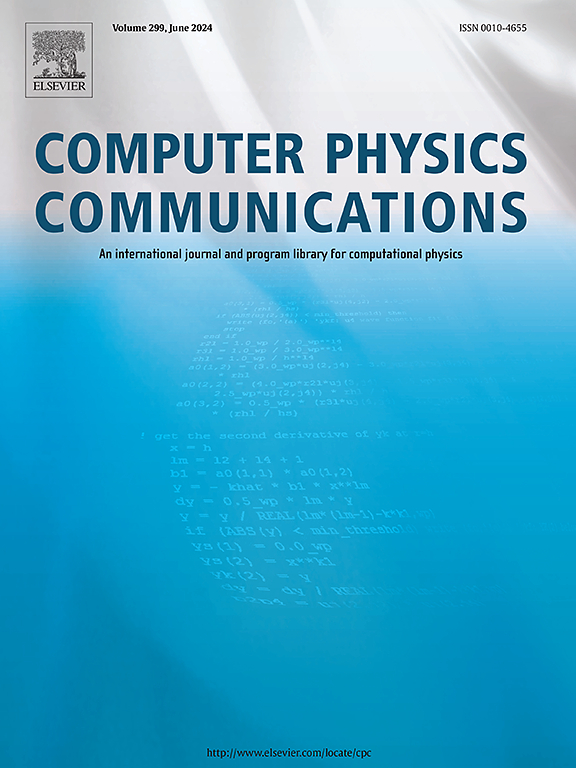自由空间中径向对称核的非周期粒子网格Ewald法
IF 3.4
2区 物理与天体物理
Q1 COMPUTER SCIENCE, INTERDISCIPLINARY APPLICATIONS
引用次数: 0
摘要
将基于fft的光滑粒子网格Ewald (PME)方法推广到通过径向对称核f(r)相互作用的非周期电荷系统。提出的非周期PME (NPME)方法首先将核函数f(r)分解为一个短程分量fs(r)和一个光滑的远程分量fl(r)。利用离散傅里叶变换插值对fl(r)的傅里叶扩展进行数值计算,从而有效地处理各向异性矩形电荷体积,并在核分裂的选择上提供额外的灵活性。对于一般的径向对称核f(r),引入了导数匹配(DM)分裂,提高了传统的Ewald分裂方法的计算性能。提出了一种优化的NPME网格存储算法,将总网格内存减少了四分之一。NPME算法在c++库NPME中实现,该库支持预定义内核(例如1/r,rα,exp (ik0r)/r)和通过c++类定义的用户定义内核。npme在计算化学和计算电磁学的测试系统上与fmm3D进行了基准测试和比较。作为实际应用,将NPME算法与矩量法(MoM)相结合,形成了一种计算完美电导体(PEC)雷达截面(RCS)的混合MoM-NPME算法。采用MoM-NPME方法计算了1米PEC球在37.8 GHz的双稳态RCS和NASA杏仁在75 GHz的单稳态RCS。程序摘要程序标题:npmeCPC库链接到程序文件:https://doi.org/10.17632/vs86pk3dpt.1Developer's存储库链接:https://github.com/ElkingD/npmeLicensing条款:Apache 2.0编程语言:c++补充材料:提供了包含额外技术细节和结果的补充材料。问题性质:npme计算包含在三维矩形体积内的N个非周期电荷的势及其梯度,这些电荷通过径向对称核相互作用。电荷、核、势及其梯度可以是实的,也可以是复的。预定义的核是由1/r rα exp (ik0r)/r给出的,其中α是实数,k0是复数。此外,用户可以用c++类实现他们自己的径向对称内核。求解方法:npme采用本文提出的非周期粒子网格Ewald (npme)方法,在O(Nlog ln N)运算中计算势及其梯度。npme使用矢量内禀函数和OpenMP优化了可变电荷和静态几何输入。额外的注释,包括限制和不寻常的功能:npme需要Intel®C/ c++编译器与数学内核库。本文章由计算机程序翻译,如有差异,请以英文原文为准。
A non-periodic particle mesh Ewald method for radially symmetric kernels in free space
The FFT-based smooth particle mesh Ewald (PME) method is extended to non-periodic charge systems interacting via a radially symmetric kernel . The proposed non-periodic PME (NPME) method begins by splitting the kernel into a short-range component and a smooth long-range component . A Fourier extension for is computed numerically using discrete Fourier transform interpolation, enabling efficient treatment of anisotropic rectangular charge volume and offering additional flexibility in the choice of kernel splitting. A derivative-matched (DM) splitting is introduced for general radially symmetric kernels , improving computational performance over traditional Ewald splitting methods. An optimized grid storage algorithm for NPME is proposed, reducing total grid memory by a factor of four. The NPME algorithm is implemented in a C++ library, npme, which supports both pre-defined kernels (e.g. ) and user-defined kernels via C++ classes. npme is benchmarked and compared to fmm3D on test systems in computational chemistry and computational electromagnetics. As a practical application, NPME is combined with Method of Moments (MoM) to form a hybrid MoM-NPME algorithm for calculating the radar cross section (RCS) of a perfect electric conductor (PEC). The MoM–NPME method is used to compute the bistatic RCS of a 1-meter PEC sphere at 37.8 GHz and the monostatic RCS of the NASA almond at 75 GHz.
Program summary
Program Title: npme
CPC Library link to program files: https://doi.org/10.17632/vs86pk3dpt.1
Developer's repository link: https://github.com/ElkingD/npme
Licensing provisions: Apache 2.0
Programming language: C++
Supplementary material: A supplementary material containing additional technical details and results is provided.
Nature of problem: npme computes the potential and its gradient of N non-periodic charges contained within a 3D rectangular volume interacting through a radially symmetric kernel. The charges, kernel, potential, and its gradient can be real or complex. Pre-defined kernels are given by where α is real and is complex. In addition, users can implement their own radially symmetric kernel with C++ classes.
Solution method: npme computes the potential and its gradient using the non-periodic particle mesh Ewald (NPME) method proposed here in operations. npme is optimized for variable charge and static geometry inputs using vector intrinsic functions and OpenMP.
Additional comments including restrictions and unusual features: npme requires the Intel® C/C++ compiler with Math Kernel Library.
求助全文
通过发布文献求助,成功后即可免费获取论文全文。
去求助
来源期刊

Computer Physics Communications
物理-计算机:跨学科应用
CiteScore
12.10
自引率
3.20%
发文量
287
审稿时长
5.3 months
期刊介绍:
The focus of CPC is on contemporary computational methods and techniques and their implementation, the effectiveness of which will normally be evidenced by the author(s) within the context of a substantive problem in physics. Within this setting CPC publishes two types of paper.
Computer Programs in Physics (CPiP)
These papers describe significant computer programs to be archived in the CPC Program Library which is held in the Mendeley Data repository. The submitted software must be covered by an approved open source licence. Papers and associated computer programs that address a problem of contemporary interest in physics that cannot be solved by current software are particularly encouraged.
Computational Physics Papers (CP)
These are research papers in, but are not limited to, the following themes across computational physics and related disciplines.
mathematical and numerical methods and algorithms;
computational models including those associated with the design, control and analysis of experiments; and
algebraic computation.
Each will normally include software implementation and performance details. The software implementation should, ideally, be available via GitHub, Zenodo or an institutional repository.In addition, research papers on the impact of advanced computer architecture and special purpose computers on computing in the physical sciences and software topics related to, and of importance in, the physical sciences may be considered.
 求助内容:
求助内容: 应助结果提醒方式:
应助结果提醒方式:


